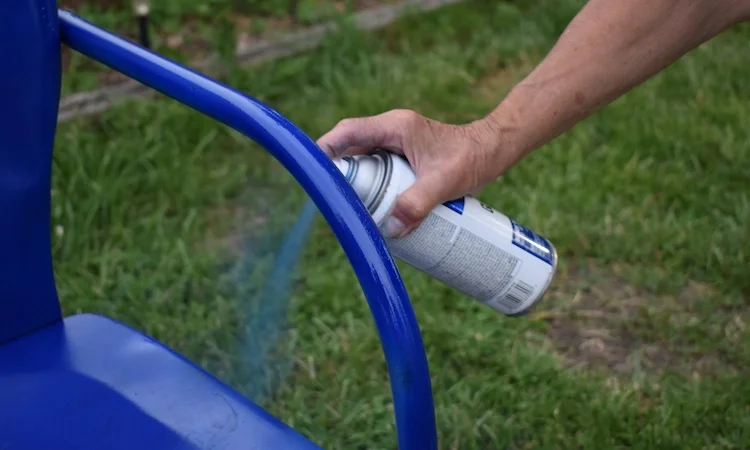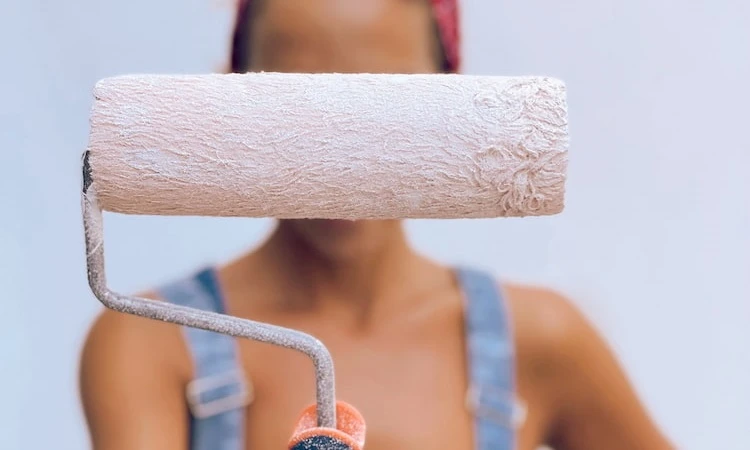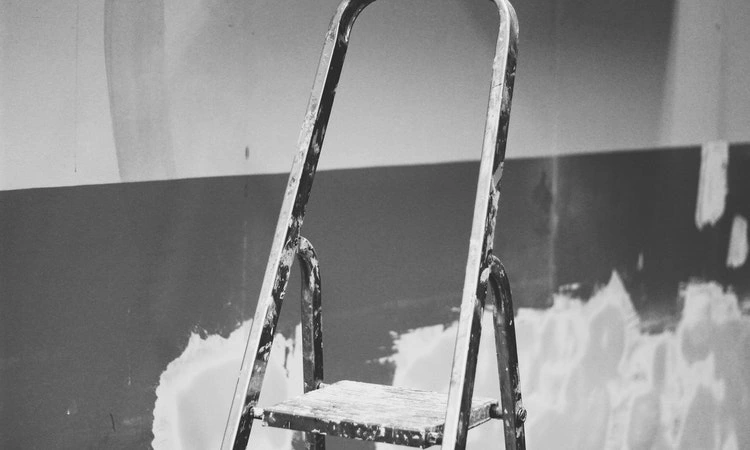Inspiration strikes to spray paint, but it is the dead of winter and 30 degrees Fahrenheit outside.
Or maybe it is summer, and it is over 85 degrees Fahrenheit every day. Can you still spray paint? What is the best temperature to spray paint?
Generally, the best temperature to spray paint is between 50 and 90 degrees Fahrenheit. Colder or warmer temperatures affect the spray paint in different ways. You can read the label on the spray paint to determine that specific paint’s ideal application temperature range.
How does cold and hot weather affect the application of spray paint? Is it possible to spray paint in colder or warmer weather?
Continue reading this article to find out the answers to those questions. I will help you understand how heat and cold effect spray paint.
I will also provide some tips on how you can spray paint in cold or hot weather.

Does Temperature Affect Spray Paint?
Temperature does affect spray paint. Spray paint is a liquid when at room temperature. Think about water.
At room temperature, water is a liquid, but at cold temperatures, water begins to harden and freeze. Spray paint does the same thing.
When water is exposed to hot temperatures, it begins to thin and evaporate. Again, spray paint does the same thing.
You should keep this in mind when you spray paint in cold or hot temperatures.
What Temperature is OK to Spray Paint?
The best temperature to spray paint is between 50 and 90 degrees Fahrenheit. It is possible to spray paint in lower or slightly higher temperatures. Later in this article, I will describe some tips on painting in warmer or colder temperatures.
It is easier to spray paint in temperatures colder than 50 degrees Fahrenheit. If the temperature is over 90 degrees, the process becomes significantly harder. Generally speaking, if the temperature is over 100 degrees, you should not be outside, let alone spray painting.
All jokes aside, this article will talk about spray painting outside in temperatures less than 50 degrees Fahrenheit and higher than 90 degrees Fahrenheit.
For the purpose of this article, I am focusing on spray painting outside. After all, you can control the temperature inside your house.
Can You Use Spray Paint in Cold Weather?
It is possible to spray paint in cold weather. There are quite a few precautions that you will need to take. If you can, you should wait until the weather warms up because it will make the painting job easier and less of a hassle.
However, some of you may not be able to wait for warmer weather. Later in this article, I will describe the precautions and steps you will need to take to ensure the paint will properly adhere to any surface in cold weather.
What Happens if You Spray Paint When it’s Too Cold?
What happens when you place milk in the freezer? It thickens and hardens. Paint does the same thing when it is exposed to cold weather. The spray paint may even become difficult to spray because of how thick it becomes.
When spray paint or any paint is exposed to cold weather, it will have an uneven flow. It can also take far longer to spray paint than if it was warmer outside. It can take longer because the thickened paint will not come out of the spray paint nozzle very easily.
If the paint comes out of the paint can fine, it will not dry the way you originally intended. The paint often becomes clumpy when it is left in the cold to dry. The paint becomes clumpy because it takes significantly longer to dry in cold weather.
Any kind of paint needs heat to fully dry. Paint will not fully dry in the absence of heat. It can take days for the paint to fully dry in cold temperatures.
Do you really want to leave your project outside for several days to let it dry? Do not fear, though. I will give you some tips and tricks on how you can spray paint in colder weather.
Related Read: How Long Does Spray Paint Take to Dry?
How Can You Make Spray Paint Work in Cold Weather?
Do you have the urge to spray paint, but it is below 50 degrees Fahrenheit? You can not always control when inspiration strikes. Thankfully, you can do a couple of things to continue spray painting when the urge hits during the winter months.
I am not going to lie; it is not an easy process. It will require more steps and preparation than a normal painting project. However, you can not always wait for warmer weather days when inspiration strikes you.
Clean the Surface
Before you begin any painting project, you should clean the surface of the item you will paint. This is especially important when you are spray painting in cold weather. Colder temperatures can affect adhesion, which is why spray paint cans have an ideal temperature listed on the can.
Therefore, you will want to ensure your project is clean of debris. It is also recommended to sand down the surface of the item. If you sand down the surface, you provide a smoother surface area for the paint to properly adhere to the item you want to spray paint.
Apply a Primer
A primer is designed to help with adhesion. Since cold weather can affect adhesion, applying a primer before spray painting your project is highly recommended.
The primer will help bond the paint to the surface you wish to spray paint.
For the best results, you should use a primer designed for your surface. For example, if you are painting galvanized metal, use a primer designed for galvanized metal.
This minor detail can have a huge impact on how well the spray paint adheres to the surface you want to paint.
Keep Items at Room Temperature
You should not take your item or spray paint outside until you are ready to paint. This will ensure that the paint and the item are at their ideal application temperature and ready for use.
The cold weather can cause the paint to harden, which will make it come out in thick globs.
The cold weather will affect the spray paint, but it will also affect the item you are painting. If your item is cold, it will be less likely to accept the paint.
Both your paint and the item you wish to paint should be kept at a normal temperature to allow for proper adhesion of the spray paint.
Let the Item Dry Indoors
As soon as you paint the item, you should bring it inside. You can let the item sit outside for 2-4 minutes, but you will need to bring it inside to fully dry. Cold weather can cause the paint to take longer to dry. It can also cause the paint to dry in clumps instead of a smooth finish.
After the paint has dried, you can take the item outside to apply a second coat if needed. Just remember to bring the item back inside and let it dry in a well-ventilated room.
Cold Weather Spray Painting Safety Tips
Most fumes from paint will be emitted when you spray the paint. However, it will still release fumes as it dries. The item should be allowed to dry in a well-ventilated area for your safety.
The volatile organic compounds (VOCs) in paint are continuously released until the paint is fully dried. VOCs can have a detrimental effect on your health and the health of those in the house.
Again, if you can, you should wait until the weather is warmer to apply the spray paint.
The best way to avoid the effects of VOCs is to paint outside and let the item dry outside. The outdoors provides the best ventilation for VOCs.
If you cannot wait for warmer weather to paint, you need to ensure that the room your painted items are drying in is properly ventilated.
Can You Spray Paint in Hot Weather?
It is significantly more difficult to spray paint in hot weather, but it is not impossible. I would not recommend spray painting in hot weather. There are simply too many things that can go wrong when you spray paint in hot weather.
Plus, I personally am not a fan of sweating while I paint. But that is just me. You may not be bothered by hot weather.
If you are not bothered by hot weather, I will describe some tips you can use to continue spray painting through the heat of the summer.
What Happens if You Paint When it’s Too Hot?
When you spray paint on a hot day, it has the opposite effect of spray painting in cold weather. Hot weather can cause the paint to thin. If the paint is thin, it will flow too easily. You will notice severe streaking on your project.
Hot weather will also cause the paint to go on in super thin coats, which means you will need to apply more coats. That can be a huge waste of your time and money. If you have to apply multiple coats of paint, you will go through the spray paint can much faster.
Not to mention thinned-out paint can cause a huge mess. The paint will likely drip while you are spraying it. It may not even reach the item you are painting. It could also splatter onto everything surrounding your spray painting area.
You should know that it is possible for the paint to dry before it fully adheres to the surface. If the weather is extremely hot, the paint may dry before it even touches the surface of the item you are painting.
This is a bit on the extreme end, but it is possible.
How Can You Make Spray Paint Work in Hot Weather?
Again, I understand that inspiration can strike no matter what temperature it is outside. Therefore, I will give you a few tips and tricks on how to spray paint in hot weather.
The process is complicated and more difficult than spray painting in cold weather.
Before I get into the tricks, you should know there is no guarantee they will help. It is still very likely the paint will crack or peel. You can proceed with the project at your own risk, and hopefully, it will pay off.
Paint in the Early Morning or Late Evening
It is no secret that the weather is cooler in the early morning and late evening. If you absolutely have to paint in the middle of summer, you should try spray painting at a time of day when the temperature outside is cooler.
You should still follow the other tips recommended in this section. However, this is probably the most important tip.
It will save you a lot of time and sweat. Honestly, who wants to be spray painting at noon in 100 degrees weather?
Clean the Surface
Do not forget to clean the surface of the item you will spray paint. Like cold weather, hot weather can affect how the spray paint adheres to the item’s surface.
You will want to ensure the item is free of debris to allow for a thorough paint application.
It is still recommended to sand down the surface as well. You do not always have to follow this extra step in normal painting projects.
However, it can significantly increase the amount of paint that can adhere to the item’s surface. Just remove the dust and debris after you sand down the item.
Apply a Primer
Remember, the job of a primer is to help with paint adhesion. The biggest obstacle with painting in hot weather is that the paint can dry before it properly adheres to the surface. A primer can help alleviate that obstacle.
Again, a primer is not always needed for normal projects, but it is required when you spray paint in hot weather.
As previously mentioned, you should make sure the primer is designed for the object you are using. For instance, you do not want to use a steel primer on wood furniture.
Keep Items at Room Temperature
You must keep the paint and the item you are painting at room temperature. Hot weather can cause the paint to thin, making it very difficult to apply.
Also, if the item you are painting is as hot as the sun, the paint will dry faster and not properly adhere to the item.
Let the Item Dry Indoors
Once again, you will have to take the paint and the items inside immediately after applying the spray paint. This step is crucial when painting in hot weather. The higher temperatures can cause the paint to dry significantly faster.
You may want to bring the item inside within one minute of applying the paint. You will still want to let the item dry in a well-ventilated room. You should also keep the item away from direct sunlight while it dries.
If you are concerned about paint fumes in your house, follow the same recommendations I made previously in the article. You can create proper ventilation in any room.
The only true way to protect yourself from VOCs is to paint outside and let the item dry outside when the temperature is ideal.
Is It OK to Let the Spray Paint Dry in the Sun?
You should not let your spray painting project dry in direct sunlight. Yes, paint needs heat to dry, but direct sunlight can cause the paint to dry too fast.
When the paint dries too fast, the paint cannot properly adhere to the surface and can begin cracking and peeling.
Are There Spray Paints Specifically Designed For Hot or Cold Weather?
Unfortunately, there is no ideal and perfect recommendation for this question. No spray paint is specifically designed for application in hot or cold weather.
You will simply have to follow the tips I have previously laid out. You should also choose a product designed specifically for the item you are painting. There is spray paint designed for galvanized metal, wood, upholstery, brick, etc.
Should You use Oil-based or Water-based paint?
Oil-based paint is known to dry slower than water-based paint. Therefore, it could be beneficial to use this type of paint when painting in warmer weather. The oil-based paint will be less likely to dry within seconds of application.
On the other hand, water-based paint may be better for cold-weather applications. Cold weather can make paint thicken and become difficult to spray.
But, by nature, water-based paints are generally thin. Therefore, they will not thicken as quickly as oil-based paints.
There is no actual scientific evidence to back this up. You should proceed with caution no matter what spray paint you use. And again, if possible, I recommend waiting until the temperature outside falls within the ideal range.
Verdict
50 to 90 degrees Fahrenheit is the best temperature range to spray paint. With that being said, you can spray paint in colder or warmer temperatures. It is more complicated and requires more steps, but it is possible.
I recommend you wait for a day when the temperature falls within the ideal range.
If you simply can not wait, then you can follow the tips I have previously described. Hopefully, your project turns out great and just how you want it to look.



